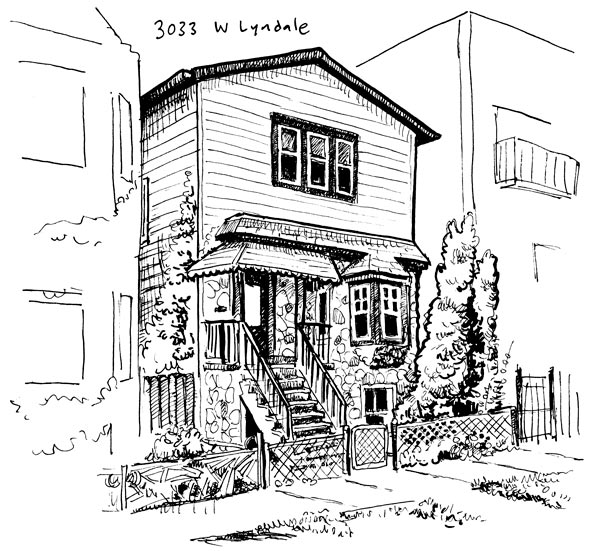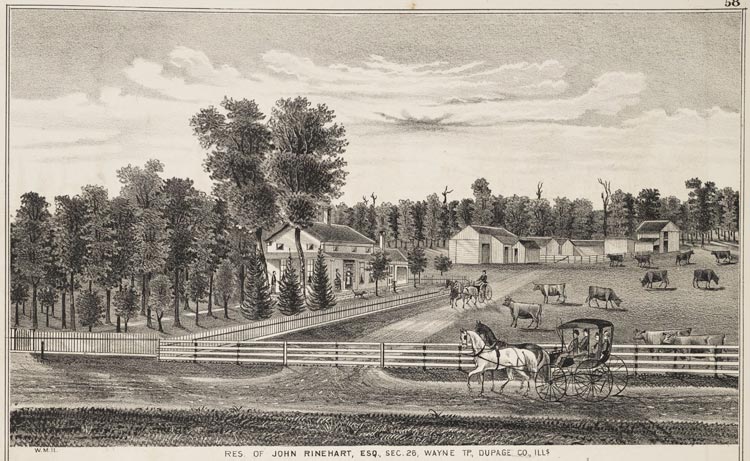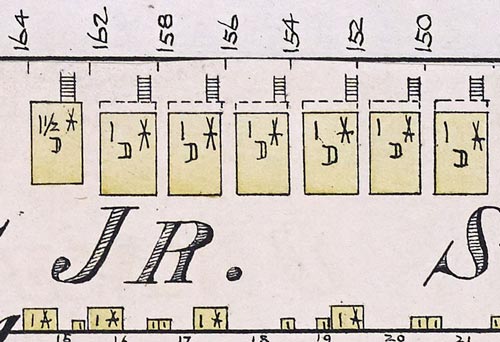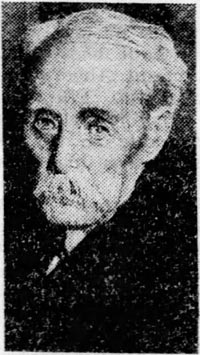
A Secret Past
In 1884, Stephen and Anna Rinehart were the first residents of the house at 3033 W. Lyndale. They raised nine children in the cottage here. Most of their nearby neighbors were immigrants from Sweden, Ireland and Germany who had arrived in America less than a decade earlier. The Rineharts were among the few American-born families on Lyndale street at that time.
Another was the Coffinberry family who lived at 3048. Like Stephen Rinehart, Creighton Coffinberry had a government job and was a Union veteran of the Civil War some twenty years earlier. Creighton was an active leader in the Grand Army of the Republic, a fraternal organization that commemorated the battles and memories of the aging soldiers. But Stephen was not a member. Perhaps he was not interested in retelling his war experiences or the years shortly after it.
Stephen's parents John & Susan Rinehart had been early pioneers who ventured west from New York in 1837 with their six young children. The youngest did not survive the trip across Lake Michigan, but the family continued on to the new town of Naperville, where they bought land and built a log cabin. Five more children were born there. Stephen was the second-youngest, born in 1844. By the time Stephen was twelve, the family had become prosperous enough to build an attractive frame house with a front porch. The house and numerous outbuildings can be seen in a lithograph from the 1870s.

John & Susan Rinehart country estate in Naperville as it appeared in the 1870s. Combination Atlas Map of DuPage County, Thompson Bro's & Burr. 1874
Stephen enlisted as a private in the 12th Regiment of the Illinois Cavalry at the end of 1863 at 19 years old. The soldiers departed Chicago in January 1864 for St. Louis and then on to New Orleans. They marched to occupied Alexandria, Louisiana in April and fought in several skirmishes there before retreating with the ill-fated Red River Expedition. The regiment was stationed in Napoleonville over the summer. In the fall they took part in campaigns in Louisiana and Davidson's raid into Mississippi. In the winter they moved to occupied Baton Rouge, Vicksburg and Memphis.
At the end of the war the 12th Regiment marched west to Hempstead, Texas northwest of Houston where they kept law and order under the command of General George Custer. In February 1866, a few months before the regiment was officially disbanded, Stephen and several other soldiers deserted their posts and left.
By the next year, he was homesteading 160-acres outside the town of Hanover in northeast Kansas. He married 21-year old Maria Mankins in June 1867, the daughter of a widow from another nearby homestead. Maria had a 1-year old daughter Fannie and the couple had another daughter Nellie several years later.
Stephen had credit from his military service toward fulfilling the 5-year residency requirement for homesteading land, so he received full title to 160 acres of land early in 1873. But less than two years later he left Kansas, leaving his wife and young daughters behind. After he left, Maria and the children moved into town, where she ran a boarding house for railroad workers. Stephen made his way to Chicago and became a partner with his brother-in-law in a grocery store in Blue Island.
By this time, most of Stephen's brothers had moved on from the family home in Naperville to become prosperous farmers in Iowa, California and New Hampshire. Only Stephen and his younger sister Susan chose to leave farming behind for the of the big city.
In 1877 he married 20-year old Anna Smith. Seven years later the couple purchased a brand new workers cottage at 3033 W. Lyndale in December 1884 from developer John Johnston Jr.'s business partner Charles M. Graves for $1,250. The house was the end of a row of six similar cottages built in the fall of that year.

Detail of 1886 Rascher's Chicago Vol. 9 fire insurance map, showing identical cottages with front porches from 150 Johnston (now 3021 W. Lyndale) to 162 Johnston (now 3033 W. Lyndale)
The four cottages in the middle of the row were raised and expanded into two-story two-flats in the early 1890s so that they are no longer recognizable as former cottages. Only the house at 3021 remains in a close-to-original state.
Stephen and Anna had three young children when they moved in, aged three to six. They went on to have six more while living in a house that was likely only about 900 square feet, not including the smaller upper floor where the children most likely slept. The family may have added a rear addition at some point to gain a little more living space.
Stephen worked as a letter carrier for the U.S. Post Office at a salary of $800 a year, which rose to $1,000 in 1891. In the 1889 city directory he is listed as a "teamster" or wagon driver for the postal service. In later years he is listed as a letter carrier. He would work for the postal service for 47 years.
After their children were grown, the Rineharts sold the house in 1919 and moved to Downers Grove.

Stephen Rinehart at 89 yrs old. Chicago Tribune, May 30, 1933
By the 1930s, not many of the old Civil War veterans were left. A few more than a hundred gathered to march with the Grand Army of the Republic in the Chicago Memorial Day Parade. In 1933 the Tribune was proud to report that their reporters had discovered a few more veterans who were not members of the organization or not regular participants. 89-year-old Stephen Rinehart was honored with a photo in the paper and marched in the parade that year. He passed away two years later. His wife Anna passed away in 1943.
Christian & Marie Schmitt bought the house at 3033 from the Rineharts, and raised five children there, but only stayed in the house four years. From 1938 to 1957 the house was owned by Camille Kettering, who lived next door at 3037 W. Lyndale.
At some point, probably in the 1950s or 60s, a second floor was added to the cottage, accessed by an internal staircase. A facade of orange permastone rocks was cemented to the first floor over the projecting bay window and around the front door.
The last owner of the house, Aben Cooper, remembers the many jigsaw puzzles glued to the walls of the rec room in the basement by an earlier resident. The front room in the basement was painted white and was a cool place to hang out on a hot summer day, watching passersby from the basement window.
The house at 3033 was demolished in June 2020 to make way for a 3-story cinder block condo.
